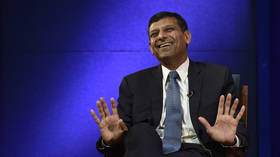Parachute Economics: Why claims that India’s growth is hyped are at odds with the evidence

Last week Raghuram Rajan, former governor of the Reserve Bank of India (RBI) and former International Monetary Fund (IMF) Chief Economist, renewed his criticism of the management of the Indian economy, cautioning against falling for what he believes to be “hype” about the country’s current growth trajectory.
The context is India’s unexpected surge in economic growth for the third quarter of 2023. While most analysts expected a growth of 6.4% for the quarter, the actual numbers came in at a staggering 8.4% – given the momentum in growth, there is every reason to believe India will clock a very impressive 8% for 2023-24.
Implicit in this growth surprise was the suggestion that India was exploring a new trend rate of growth – around 7%, compared to the existing 6%.
Rajan’s reaction was an argument that it would be a mistake to buy into this claim.
“The greatest mistake India can make is to believe the hype [about growth]. We have got many more years of hard work to do to ensure the hype is real. Believing the hype is something politicians want you to believe because they want you to believe that we have arrived,” he said.
The official reaction was not long in coming. Economists like Arvind Virmani, former chief economic adviser and presently member of government policy think tank Niti Aayog, and Arvind Panagariya, chairman of the newly constituted 16th Finance Commission, dismissed Rajan’s criticism.
In an unkind cut, Virmani accused Rajan of thinking like a parachute economist – an expert attached to multilateral institutions but equipped with little or no knowledge on the local economy and offering just policy advice.
To be fair to the government, analysts, both in the private sector and in multilateral institutions, have collectively flagged India’s growth potential. They are inspired by its ability to ride out the unprecedented back-to-back shocks, beginning with the Covid-19 pandemic, and then to thrive in subsequent years. This resilience, they argue, is inspired by the series of structural reforms undertaken by the government in this period.
Message vs Messenger
Frankly, the problem here is not with the message but with the messenger.
Rajan, through his public association with Rahul Gandhi, the former President of the Indian National Congress, India’s principal opposition party, especially in talking up some quixotic economic ideas propounded by Gandhi, has moved out of the neutral corner. To be sure, officially he is not a member of the Congress party.
However, in public life, like in politics, it is not what you do, but what you are seen to be doing.
Rajan is perceived as aligning politically with a party that is dead opposed to the incumbent Bharatiya Janata Party (BJP)-led National Democratic Alliance (NDA). As a result, the former governor’s trenchant critique has come to be viewed with suspicion as motivated.
Shorn of politics, Rajan is arguing that India is a work in progress. Ironically, the NDA, too, believes this.
Given that it is general-election season in India – with polling to begin on April 19 and continue till June 1, the NDA is showcasing its success in fixing legacy deficits with respect to access to basics like toilets, banking, cooking gas, electricity, drinking water, health insurance, internet, and so on.
Staking claim to this achievement, NDA coined a moniker around their star campaigner, Prime Minister Narendra Modi: “Modi ki guarantee” (Modi's guarantee). In almost every public rally or speech since then, Modi has invoked this slogan to promise “unprecedented prosperity” in the next five years if voted back to power.
Effectively, the prime minister is arguing that, having resolved the foundational handicaps, the stage is set to launch the next phase of India’s growth that would be far more inclusive than what had been achieved in the first six decades. Implicitly, the NDA is accepting the fact that India is a work in progress—exactly what Rajan is saying.
India@2047
Where they differ is in their respective beliefs and the plan to deliver on India’s growth potential.
Even before the general election bugle was sounded the NDA signaled that it had a plan for India to evolve into a developed country by 2047, when its economy would measure $30 trillion – an audacious claim, given that at present it is $3.7 trillion. It has already promised an active first 100 days in office, if reelected.
The ideological underpinning of this strategy is that a strong economy is a necessary condition for India to acquire military and diplomatic clout. A teaser shared by Niti Aayog reveals that India’s per-capita income will double to $4,418 by 2030 and then grow to $10,021 by 2040 and $17,590 by 2047.
Indeed, if this was to happen, then the deficits cited by Rajan, such as literacy and skilling, must be overcome. While the NDA believes this will be achieved, Rajan disagrees. But this is a case of ‘he said, she said’. Either claim can only be verified over time.
Till then, whatever be the motivations, it is best for both sides to agree to disagree.
The statements, views and opinions expressed in this column are solely those of the author and do not necessarily represent those of RT.















